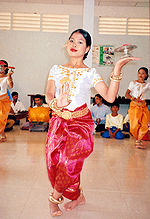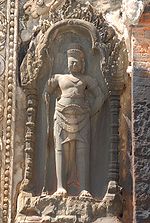- Chang kben
-
Sampot chang kben (Khmer: សំពត់ចងក្បិន, Thai: โจงกระเบน, chong kraben) is a lower-body, wrap around cloth worn in the countries of Cambodia, Laos, and Thailand. It is the preferred choice of clothing for women of upper and middle classes for daily wear. This practice of daily wear died out in the beginning of the 20th century. Unlike the typical Sampot, it is more of a pant than a skirt. It is a rectangular piece of cloth measuring 3 meters long and one meters wide. It is worn by wrapping it around the waist, stretching it away from the body, twisting the ends together then pulling the twisted fabric between the legs and tucking it in the back of the waist.
History
The history of Sampot Chang Kben dates back to ancient Cambodia, where deities were often portrayed wearing such styles. References to most Khmer elders told a legend related to this garment; it said that a long time ago, the Khmer people worn Sampot Chang Kben, followed by Indian. In those times, India provided many religions, but the most important one was Hindism, as the Khmer King at that time built the temples such as Angkor wat, also dedicated to Hindism. In the era of the Khmer empire, most of the people were likely to read and see The Reamker at the Angkor wat carving in the first floor as well. The origin of Sampot Chang Kben is known as Indian. Also prayed and blessed to was a deva known as Hanuman, the guard of Prince Rama in Indian's famous mythology, Ramayana, as well as the Khmer adaptation, Reamker. To show its power, Indians preferred to wear the Sampot Chang Kben as their costume but today, countries under the Greater India, such as Cambodia, also wear it for special occasions.[1]
In the Ramayana mythology, Hanuman is a symbol of bravery, cleverness, and power, so the people, when wearing the Sampot Chang Kben, always drop a tail at the back like the tail of Hanuman. This practice lead a lot of people to believe that all Indians were guards of Hanuman. The influence of Sampot Chang Kben, known as Dhoti in India, were strongly sacked into Khmer culture from the ancient times to today. Apparently, this fabric is also known to be worn by Tamil people in South India, as well as Khmer people, till today.[2]
In fact, Sampot Chang Kben is the tradition of Southern India, and was imported to early Cambodian Kingdom, Funan by King Kaundinya I.[3]
In the middle of the 13th and 14th centuries, Thai people (from Sukhothai Kingdom, known as Thailand today) and Lao people (from Lan Xang, known as Lao today) had adopted the wearing of Sampot Chang Kben because they considered it superior for enjoying the special occasions, and useful for royalty or monarchy in their local royal palace, because the Thai people and Lao people had used Sampot Chang Kben in a similar way.[4]
In ancient times, the Sampot Chang Kben was worn only by men, but in modern times, it is worn by both men and women, especially for a formal celebration; it is for instance worn by a bride and groom in a Khmer wedding. The general style of the garment has changed over the eras:
- King Norodom (1834–1904), During this time, most people wearing the Sampot Chang Kben kept the length down to the middle of the waist.[5]
- King Sisowath (born 1840, died 1927), During this time, the Sampot Chang Kben was worn higher up, just under the knee, like the model of Thai people. In Cambodia before, only men worn the garment, but in Thailand it was worn by both genders. When people from Cambodia saw Thai ladies wearing the Sampot Cheng Kben, they began to adopt this practice.
Today, the Sampot Chang Kben is worn mostly for formal occasions, or by royalties.
References
See also
Categories:- Cambodian clothing
- Skirts
- Trousers and shorts
- National costume
Wikimedia Foundation. 2010.



